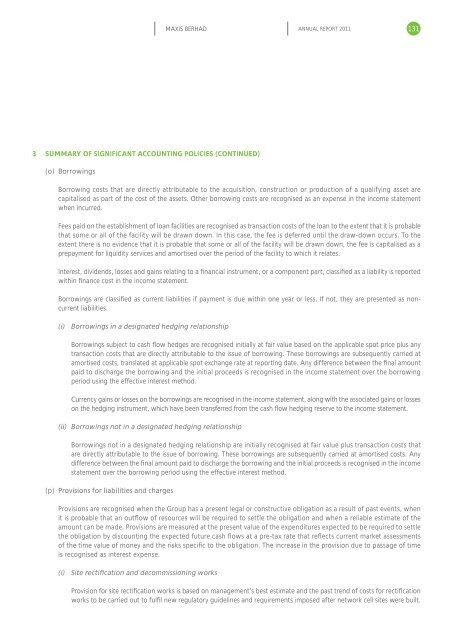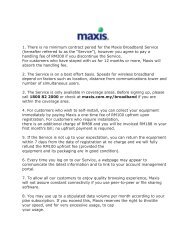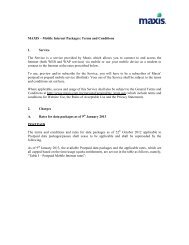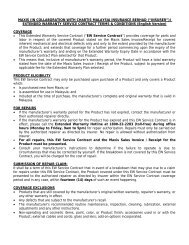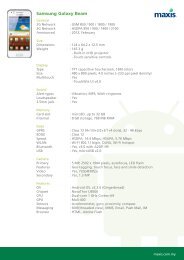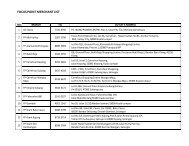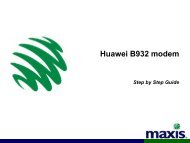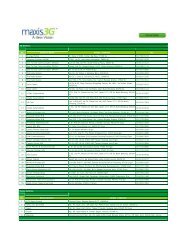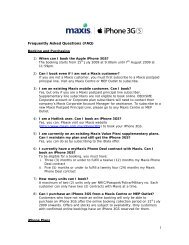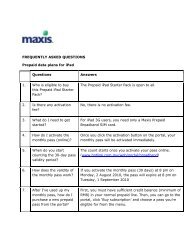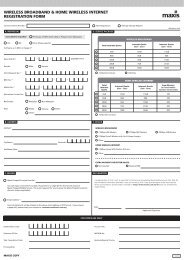ENRICHING LIVES EXPANDING HORIZONS - Maxis
ENRICHING LIVES EXPANDING HORIZONS - Maxis
ENRICHING LIVES EXPANDING HORIZONS - Maxis
You also want an ePaper? Increase the reach of your titles
YUMPU automatically turns print PDFs into web optimized ePapers that Google loves.
MAXIS BERHAD<br />
ANNUAL REPORT 2011<br />
131<br />
3 SUMMARY OF SIGNIFICANT ACCOUNTING POLICIES (CONTINUED)<br />
(o) Borrowings<br />
Borrowing costs that are directly attributable to the acquisition, construction or production of a qualifying asset are<br />
capitalised as part of the cost of the assets. Other borrowing costs are recognised as an expense in the income statement<br />
when incurred.<br />
Fees paid on the establishment of loan facilities are recognised as transaction costs of the loan to the extent that it is probable<br />
that some or all of the facility will be drawn down. In this case, the fee is deferred until the draw-down occurs. To the<br />
extent there is no evidence that it is probable that some or all of the facility will be drawn down, the fee is capitalised as a<br />
prepayment for liquidity services and amortised over the period of the facility to which it relates.<br />
Interest, dividends, losses and gains relating to a financial instrument, or a component part, classified as a liability is reported<br />
within finance cost in the income statement.<br />
Borrowings are classified as current liabilities if payment is due within one year or less. If not, they are presented as noncurrent<br />
liabilities.<br />
(i) Borrowings in a designated hedging relationship<br />
Borrowings subject to cash flow hedges are recognised initially at fair value based on the applicable spot price plus any<br />
transaction costs that are directly attributable to the issue of borrowing. These borrowings are subsequently carried at<br />
amortised costs, translated at applicable spot exchange rate at reporting date. Any difference between the final amount<br />
paid to discharge the borrowing and the initial proceeds is recognised in the income statement over the borrowing<br />
period using the effective interest method.<br />
Currency gains or losses on the borrowings are recognised in the income statement, along with the associated gains or losses<br />
on the hedging instrument, which have been transferred from the cash flow hedging reserve to the income statement.<br />
(ii) Borrowings not in a designated hedging relationship<br />
Borrowings not in a designated hedging relationship are initially recognised at fair value plus transaction costs that<br />
are directly attributable to the issue of borrowing. These borrowings are subsequently carried at amortised costs. Any<br />
difference between the final amount paid to discharge the borrowing and the initial proceeds is recognised in the income<br />
statement over the borrowing period using the effective interest method.<br />
(p) Provisions for liabilities and charges<br />
Provisions are recognised when the Group has a present legal or constructive obligation as a result of past events, when<br />
it is probable that an outflow of resources will be required to settle the obligation and when a reliable estimate of the<br />
amount can be made. Provisions are measured at the present value of the expenditures expected to be required to settle<br />
the obligation by discounting the expected future cash flows at a pre-tax rate that reflects current market assessments<br />
of the time value of money and the risks specific to the obligation. The increase in the provision due to passage of time<br />
is recognised as interest expense.<br />
(i) Site rectification and decommissioning works<br />
Provision for site rectification works is based on management’s best estimate and the past trend of costs for rectification<br />
works to be carried out to fulfil new regulatory guidelines and requirements imposed after network cell sites were built.


